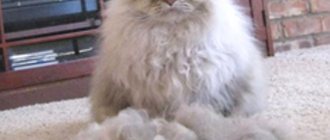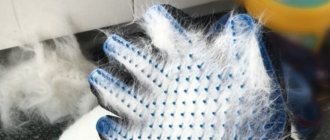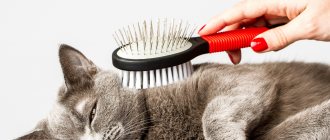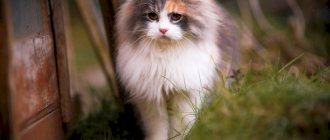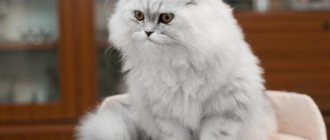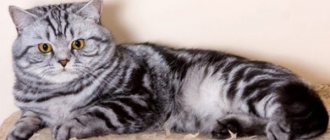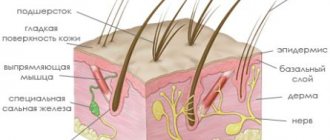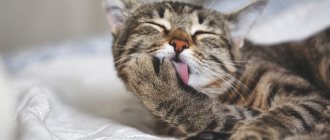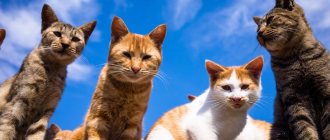Cat fur serves as an insulating layer between the skin and the external environment. The coat protects from cold and heat. Its type is classified depending on the thickness, length, and structure of the hair.
The type of cat's coat is an individual feature of each breed, regardless of color, and is determined by a specific combination of guard hairs, guard hairs and undercoat.
Undercoat
The undercoat consists of soft and fluffy hairs of equal diameter along the entire length, providing thermal insulation. It is the undercoat that helps animals keep warm during cold periods and protects them from overheating in hot weather. Without proper care, the undercoat becomes compacted, tangled, and tangles form. They are much larger in number, in contrast to the protective and guard layers, and they are the shortest, lying close to the body. When examining the undercoat under a microscope, it will appear corrugated (wavy), although at ordinary glance it appears straight.
Guard hair
The guard hair, or outer hair, forms the main middle layer of the coat. They are thinner than protective hair, stiff, with a thickening at the tip. The structure and length may vary depending on the breed. Some breeds have a awn that is the same length as the guard hair, while others have a shorter awn.
Protective hair
The guard hair usually determines the cat's base color. The protective top layer prevents the wool from getting wet quickly. Typically, guard hairs are longer than guard hairs, and are stiffer and coarser. They taper evenly to the tip along the entire length.
Pooh
Sparse, very fine hairs, characteristic of kittens. By the way, sphinxes’ hair is also called fluff. In adults, the down is difficult to distinguish.
Mustache
Vibrissae are long, thickened tactile hairs growing on both sides of the muzzle on the cheeks and above the eyes, as well as on the outer side of the lower leg. Vibrissae are very sensitive and important in a cat’s life. They cannot be cut, because with the help of whiskers the cat orients itself in space: it measures the distance to an object, finds its way in the dark, determines the direction of the wind, and recognizes odors. Whiskers are one of the ways cats communicate.
There are breeds with double or triple coats. Many people believe that some breeds do not have an undercoat, for example, the Turkish Angora, but in fact they do, it’s just weakly expressed, it is less abundant, unlike other breeds. Representatives of the Cornish Rex breed lack a awn, and wirehair cats have all three types of hair, they are all short and curly.
By the way, hair structure is determined genetically. Straight and curly hair in cats differ only in the shape of the shaft. Curly hair has a flat shaft, while straight hair has a round shaft.
Cat fur length
Hairless rocks
Despite the name “hairless,” there are no naturally hairless cats. Even hairless breeds have very short, fine hairs on their bodies, most noticeable on their limbs. But they are not enough to protect the skin from exposure to low and high temperatures and sunburn. Hairless breeds have whiskers and eyebrows, but they are shorter than other coated breeds.
A recessive gene is responsible for the lack of hair, which must be present in both parents in order for hairless kittens to be born. Hairless breeds include the Sphynx, Peterbald, and Bambino. The lack of full fur makes it easier to care for animals, but they tolerate cold less well.
Shorthair
Most cat breeds have short hair, less than 5 cm long. These include the British Shorthair, Bombay, Burmese, and Bengal breeds. But there is significant variation in texture among different breeds. For example, Siamese and Oriental cats have short, but smooth, very soft, close-to-the-body fur, while the Russian Blue has a thick double coat, soft and silky in texture.
The coat of shorthaired breeds requires minimal grooming. Brushing 1-2 times a week will help maintain a healthy and beautiful appearance of the animal, get rid of dead hair, and prevent the formation of tangles.
Semi-longhair
This concept applies to breeds with long hair, but not such a thick and fluffy undercoat compared, for example, with Persian and Himalayan cats. As a rule, in semi-long-haired breeds there is a noticeable difference in the length of the coat in summer and winter. These breeds include the Maine Coon and Burmese cat.
Longhair
Representatives of some breeds are characterized by wool reaching a length of up to 12 cm. But the length depends on the breed and the season of the year. In winter, the coat is typically longer and thicker, providing insulation from the cold. Long-haired breeds require careful care, because the wool is prone to tangling, and debris in the form of seeds and twigs gets stuck in it. Animals shed profusely. Therefore, you need to care for long-haired animals every day.
Long-haired breeds include Persian, Neva Masquerade, Himalayan, and Scottish longhair cats. A recessive gene is responsible for long hair, so to produce long-haired kittens, parents who are carriers of this gene are needed.
Genetics and breeding
The length of the coat is determined primarily by the allelic state of the L (Long) gene. The recessive allele of this gene lengthens the time of hair growth, due to which homozygotes ll develop elongated hair. However, the expression of this gene is characterized by great diversity, which is quite amenable to targeted selection. Both Persian and Balinese cats have the same genotype at the L locus, but the coat of the first is 3-4 times longer than that of the second! In other words, the length of the coat is influenced by some modifier genes that are still unknown to felinologists.
Rex mutations
determine changes in wool texture. This group of mutations is quite extensive and diverse in its manifestations. A general indicator of belonging to it is the presence of crimped hairs with a disturbed structure. The very first recorded mutation of this group was the Cornish Rex (or Cornish Rex - according to the place where the mutation was found).
Typically, a cat's coat includes three types of hair. The thinnest, short and soft, crimped hairs are called undercoat or underfur. The awn is represented by hairs with a convoluted base and a straight tip, and the longest, coarsest and straightest hairs make up the outer coat.
In the Cornish Rex, although the outer coat and guard hairs are present, they are very thin, crimped and of equal length to the underfur, so that they are almost indistinguishable from it. This hair forms wavy curls of a closed type, that is, the ends are oriented towards the skin. The vibrissae of these mutants are also convoluted. The Cornish Rex gene is inherited in a recessive manner and is designated r. Based on the Cornish Rex mutation, a separate breed was created under the same name.
The second rex mutation discovered is the Devonshire Rex, or Devon Rex, which differs in appearance from the Cornish. These cats have no outer coat, the curls do not have a clear direction (the so-called open type), and the curled coat differs from the undercoat in length and thickness. The vibrissae are also convoluted. An independent cat breed was also created based on this mutation. When crossing Cornish and Devon Rex, the offspring of the first generation have normal hair. It follows from this, firstly, that Devonian rex is determined recessively, and secondly, that this mutation is not localized in the R locus.
The Devonian rex allele is called re (and the locus, respectively, Re). This situation, in which two mutations, similar in appearance, are determined by different genes, is called pseudoallelism. The genotype of the offspring obtained from the Cornish and Devon Rex can be written as RrRere. Therefore, the genotypes of their parents are rrReRe and RRrere. The coat of Rex hybrids is normal, since in each of the parents one of the mutant loci is represented by a pair of normal alleles. When individuals of the first generation are mated to each other, the classic splitting of dihybrid crosses can be observed in their offspring: 9 normal-coated: 3 Cornish Rex: 3 Devon Rex: 1 “double” Rex, carrying characteristics of both the Cornish and Devon mutations (Table 6) .
Of course, “Cornish” and “Devon Rex” in this example do not mean the breed, but only the type of coat texture.
In the USA, the Californian rex is also known - a mutation that does not yet have its own genetic designation.
The rex mutation discovered in Germany, which gave rise to the German Rex breed, has an external manifestation similar to the Cornish Rex. Unlike other rex mutations, it turned out to be allelic to r. In other words, this mutation is either the same as that in the Cornish Rex, or, if not identical to it, then it is located at the same locus. The genetically correct entry for the German Rex genotype is rgrg.
The Danish Rex is a fundamentally different mutation compared to those described above. The coat of these cats is wavy only at birth, and with age it is replaced by thin, sparse, but straight hair. Only the vibrissae remain curled. The inheritance of this mutation is dominant, the allele designation is Rd.
The Selkirk Rex mutation (genetic symbol Se) also has dominant inheritance. The fur of these mutants is thick, soft, without outer hair, and lies in large waves. A breed based on this mutation and under the same name is currently just being formed.
In general, the discovery of rexoids in populations of both outbred and purebred cats is not uncommon. Over the 6 years of development of felinology in Russia, rex mutants were discovered among the aboriginal cat population in the Urals (in the Yekaterinburg region), and cleavage of curly-haired cats in the Persian breed was repeatedly noted.
The first of the discovered mutations, called Ural Rex, is characterized by a crimped undercoat and the presence of a thin, curly awn. The outer hair is practically not expressed. The resulting curl is closer to the open type. The whiskers, as well as the fine hair on the paws and muzzle, are curved and thinned. Compared to genotype ll (long-haired), these rexes show a medium coat length.
Data on the nature of inheritance of the Ural-Rex mutation (presumable genetic symbol Ru or ru) indicate its recessive inheritance. It is also known (thanks to the experiments of O.S. Mironova) that the Ural Rex is not an allelic mutation in relation to the Cornish Rex.
Based on this mutation, attempts are being made to create a new breed of rex, mainly through inbreeding. It is a pity that information about the fixation of mutations and the desired breed type rarely leaks into print, and the animals themselves do not appear at exhibitions very often.
In the area of the city of Yekaterinburg, independently of the one described above, another group of aboriginal rexoid cats was discovered. It is quite possible that this is the second rex mutation in the Urals (in Beloyarsk), independent of the Ural-rex. The fur of these rexoids is short, thick, on the body it consists of outwardly almost uniform hairs (like those of the Cornish Rex, but of a coarser texture), lying in dense curls of a closed type. Vibrissae convoluted. The paws and muzzle are covered with short and almost straight dense fur, even in most adult animals. Kittens are born with soft, curled baby down, then, at one month of age, develop normal baby hair, softer than that of normal cats, but not curled. At the age of over three months, the change from a straight spine to a convoluted one begins. It appears that this feature of the newly discovered rexoids depends either on gene dosage or on the accumulation of modifier genes.
Apparently, the second is more likely, since breeders define the type of inheritance of this mutation as strictly recessive, however, with an increase in the number of generations during related matings, there is a tendency to preserve the curled coat in kittens. A group of such rexoids, which have not yet received an official name, are bred in a system of inbreeding. It seems undesirable to mix two different groups of Ural rexes in breeding, but it is advisable to at least establish the allepicity of these mutations.
Rexoids have been found more than once among Persian cats. The reasons for their appearance can be very different: spontaneous (random) mutagenesis, and mutagenesis due to domestication, and, possibly, the introduction of rexoid genes into the breed that once took place (similar experiments are mentioned by R. Robinson in the book “Genetics for cat breeders” ).
Despite some differences in coat texture and different origins of mutations, all Rexoid Persians generally retain a long, crimped coat with a significant amount of awning. Their vibrissae are, of course, convoluted. Is it worth creating a new breed based on each mutation of this type that appears? Of course not. With rare exceptions, Rex Persians look extremely untidy, and caring for their coat is difficult.
So far, one more or less successful experience in creating such a breed is known - the Czech curl cat.
Similar cats were often registered in Moscow and other Russian cities, for example, Volgograd. One of these Moscow rexoids was distinguished, in addition to its long curly hair, by the presence of hard, curved or even broken hairs on its paws, protruding above the general level of the coat. The inheritance of this mutation was apparently recessive. Breeding work with her (using backcrossings) was soon stopped, primarily due to the low viability of rexoid kittens.
The Volgograd mutation is currently only being studied.
Wire wool
- a mutation with a dominant type of inheritance (genetic symbol Wh - Wire hair), which underlies the American wirehair cat breed. The coat of carriers of this allele is represented by all three types of hair, only the outer hair and awn are thinner than in ordinary cats, and are sharply curved, almost broken. The hairs of the undercoat, on the contrary, are thickened and also curved. To the touch, the fur of such cats is rough and elastic.
Thin wool
should be considered as a disadvantage rather than as an anomaly interesting from the point of view of the breeder. The coat of animals carrying this mutation in the homozygous form is thin, shortened, often deformed and very thinned out with areas of baldness. This gene is designated by the symbol sf (Sprace fur) and its inheritance is recessive.
Cotton wool
or Samsonity is determined by the recessive allele sa (Satin). The coat of homozygotes for this allele is thin and thick; the structure of the hair is disturbed, as a result of which it loses its rigidity. Their outer coat is difficult to distinguish from the guard coat due to the disruption of the hair structure.
Lack of fur (atrichosis)
this phenomenon is also represented by a whole group of non-allelic mutations. So far, the inheritance of only three variants of hairlessness in cats has been studied.
French hairlessness
- the first of the described mutations, with recessive inheritance, genetic symbol h. Kittens are born covered with baby downy fur, which subsequently disappears. Sometimes adult animals retain real hair, especially on the legs, tail and face. The whiskers of these cats are straight.
Canadian hairlessness
Despite the external resemblance to the French one, this mutation belongs to a different locus - hr - and is also determined by a recessive gene. On its basis, the Canadian Sphynx breed was created.
Mutation hd
as is clear from its genetic symbol, it is recessive and not allelic to those described above. Homozygotes for this mutation have skin that is soft and elastic at birth, but becomes thick and wrinkled with age.
The vibrissae are curved. The viability of homozygotes for this mutation is clearly reduced, most of them die at an early age.
In Russia, a hairless mutation with dominant inheritance was discovered, on the basis of which there is now an active process of creating two breeds - Russian Hairless, based on the aboriginal type of cats, as well as another breed, which does not yet have an established name, based on the oriental type. The appearance of this mutation, which has not yet been registered under an official genetic symbol, is broadly similar to that of the Canadian Sphynx.
Among kittens with the hairless gene of domestic origin, breeders note several types (we are talking only about heterozygotes for now!): naked-born, “velor” - with rudimentary hairs all over the body, rexoid - covered with fairly thick soft wavy hair, and “bristly” - covered with hard , crimped, almost broken wool. On the crown of the last two types of kittens there is often a visible bald spot - a “tonsure”. All types of kittens have curled whiskers.
Kittens shed their fur as they develop, and the speed at which this process will occur can be determined by the texture of the fur at the age of 1-2 months: if the fur remains thin and silky, the kitten will “undress” by 4-5 months, and in the case of more hard, almost broken wool - this process can take up to a year or longer. Despite the dominance of the mutation, its manifestation is affected by the dose of the gene: it is likely that homozygous individuals turn out to be homozygous, completely devoid of hair and whiskers, with very extensible skin that forms folds. So far, no impairment of viability has been observed in carriers of this mutation, but late puberty has been observed in cats and sometimes a decrease in the size of animals. Just like the Canadian Sphynx, domestic hairless cats often have a widened and flattened bridge of the nose, which is most likely one of the results of the action of a mutant gene. These cats often have a shortened lower jaw, a weak chin, and overdeveloped fangs and claws.
Skin asthenia
determined by the dominant allele Cat. Carriers of this mutation have a lack of collagen fibers in the skin, as a result of which it becomes highly extensible and becomes susceptible to various damages.
Source Vandvis Cattery
What is the difference between wool and hair?
All mammals have hair, be it human, pig, elephant, whale, cat or dog. But they have different appearances, depending on their functional purpose. Technically speaking, the term "fur" applies to mammals with very thick hair. The term "coat" is used for cats, except for hairless breeds, which have a minimal amount of fur, so the term "hair" is applied to them.
But like everything else, cat hair grows from follicles under the epidermis, although they come in different types and structures. By the way, a mustache is also considered hair. Cats have different types of hair growing from the same follicle. Each awn is surrounded by 6-12 fluffy hairs.
Hair has different textures and lengths on different parts of the body. Their density varies from breed to breed, the number of hair follicles in certain areas of the body. But on average, the density of the coat is about 200 hairs per square millimeter.
Directly under the skin are hair muscles that are sensitive to changes in ambient temperature. When a cat is scared, anxious or cold, the muscles tense, raising the hair. Protruding and fluffy, they give the animal a “frightening” appearance.
Skin parasites in cats
Very often, the causes of significant thinning of the coat in cats are skin parasites, namely fleas, lice mites and scabies mites, which cause a number of diseases:
- Demodicosis, notoedrosis - infection with scabies mites that live under the skin or in hair follicles. In sick cats, hair comes out all over the body in clumps, sores, scabs and wounds form from scratching with claws.
- Otodectosis is ear scabies, in which the affected area is concentrated in the area of the outer and inner ear. The cause of the disease is microscopic mites. With this disease, hair grows in the cat's ear area.
- Cheyletiellosis or wandering dandruff in cats is characterized by intense hair loss on the sides of the body. However, the most pronounced symptom is transient white or black dandruff. The cause of the disease is microscopic mites that live in desquamated particles of the epidermis (dandruff)
- Flea infestation (flea infestation) entails constant itching, sores, hair loss in clumps in areas of intense scratching and severe anxiety of the animal.
Diagnosis and treatment
The best diagnostic methods for shedding cats are:
- superficial or deep scraping from the affected area of the body to determine the type of tick under a microscope;
- Scotch tape test is a home option for determining skin parasites (in veterinary medicine it is also used in laboratories as an express method);
- The method of combing a cat on white paper allows you to find feces and flea larvae in the fur (relevant for black and dark colors).
Treatment is aimed at the use of specific veterinary drugs:
- for scabies (demodex, notoedrosis, cheyletieliosis) - drops on the withers Stronghold, Lawyer, Inspector;
- against fleas and lice eaters - any insectoacaricides for cats (drops, shampoos, sprays).
- for otodectosis - drops in the ear with anti-mite action (Amit, Amirazin, Otoferonol, Bars).
Are there allergies to wool?
Cat saliva contains particles of the Feld1 protein, which gets onto the fur when the cat licks its fur. The particles dry out, turning into microscopic flakes, and they are the allergen. Some people, misled, look for animals without fur, believing that there are no allergies to them. In fact, there are no breeds that do not cause allergies, but some cat breeds are hypoallergenic, meaning they are less likely to cause allergies.
Similar articles:
- Declawing cats
- Cats with the character of a dog
- Cat Day
- Cats from advertising
- Cat foster care
- Fertility of cats
How to trim or shave your pet if necessary?
Hairdressing procedures at home are carried out according to a certain algorithm:
- Trimming nails. It is carried out with special tweezers, pre-disinfected. Light pressure on the paw pads causes the hidden claws to extend; the owner only needs to trim the very tips. This procedure will prevent scratches during cutting.
- When performing the initial manipulation, an assistant is needed - he must hold the animal, preventing it from running away. Some cats become aggressive when they see grooming tools. For safety, the pet is wearing a plastic collar that prevents it from biting.
- The cat is laid on its side, its paws are securely fixed. For cutting, use a clipper or scissors. The first will avoid damage to the skin, but can irritate and frighten the pet with its buzzing.
- The fur is removed from the sides, then moved to the back and belly. Hair removal is carried out both in the direction of its growth and in the opposite direction. The remaining long hairs are trimmed with nail scissors. There must be a tassel on the tail.
After the procedure is completed, the pet is bathed with a special cat shampoo and dried with a towel. If the animal is not afraid of a hair dryer, then it is also used for drying. Veterinarians recommend using the services of specialists. The groomer will carry out the manipulation quickly, without injuring the cat’s delicate skin or damaging the whiskers.
How often can you shave or cut your pet's hair? The fur grows back within 3-6 months. If spots form, the animal grows unevenly, then it needs to be shown to a veterinarian.
The structure of cat hair
In general, the structure of cat hair is approximately the same as that of all mammals. The central part is occupied by a heart-shaped layer, consisting of keratinized cells separated by air spaces. At the base and apex of a mature hair, the core is absent, and in its place a hollow channel is formed.
Outside the core there is a middle, cortical layer, consisting of spindle-shaped keratinized cells elongated along the axis of the hair and welded together. This layer determines the strength and elasticity of the hair. The cells of the core and cortex contain grains of pigment that give the hair a particular color.
The surface of the hair is covered with a thin scaly layer (cuticle), formed by elongated flat keratinized cells that do not have pigment and protect the hair from harmful influences. The shine of the hair depends on the shape of the cuticle scales and their location - the smaller and denser they are pressed against each other, the brighter the coat shines.
All hair cells contain large amounts of the water-resistant protein keratin. But most importantly, they are all dead and incapable of regeneration. The life of the coat and hair glimmers in the follicle - the hair follicle. And so it is arranged differently in different species of mammals. Let's take a closer look at the features of cats' fur.
Wool does not get sick separately
Do you remember our comparison of a follicle with a pot in which a hair flower grows? Following this analogy, it is easy to understand that only environmental conditions and the composition of the water with which you water it can ruin a flower. Of course, if we assume that the soil in the pot is initially fertile.
Nature has protected cats' fur from external conditions quite well: it tolerates wind, snow, rain, dirt, and an endless amount of getting wet and drying out perfectly. It is difficult for her in apartments with central heating, when the air in the room becomes too dry, but even here the safety margin of wool is quite high.
What determines the quality of wool?
The tap water you sometimes use to wash your cat usually meets sanitary standards, and you also choose the right shampoo, right? Therefore, we can safely say: the quality of a cat’s fur depends entirely on its nutrition and state of health.
Excessive hair loss, and even more so the appearance of bald patches, is a reason to consult a doctor. The most common causes of hair problems can be an infectious disease, hormonal imbalance, external and internal parasites, an unbalanced diet poor in vitamins and microelements, and allergic reactions.
The main conditions for healthy fur are: a high protein content in the food, the presence of B vitamins, polyunsaturated fatty acids Omega 3 and Omega 6. Only a balanced diet and good health are the key to the beauty of a cat’s coat.
Hair that can "see"
When creating vibrissae, nature acted as an innovating engineer. Taking ordinary hairs as a basis, she modified them so much that they turned into a unique ultra-sensitive device. The longest vibrissae are located above the upper lip (on both sides in four rows), much shorter ones are located on the chin, in the cheek area and above the eyes, as well as between the pads on the paws.
Structure and tasks of vibrissae
The vibrissae are arranged in a very special way: the base of each of them is immersed in a hair follicle, to which hundreds of nerve endings approach. Each vibrissa on a cat's head is connected to its own area in the cat's brain via the trigeminal nerve.
Vibrissae help the cat navigate in the dark, determine the size of narrow holes in its path, the location of an object and even the distance to it, recognize the strength and direction of the wind in order to accurately calculate the jump.
When a cat hunts, its whiskers are extended and record any movement in the space around it. With the help of whiskers, the animal controls the behavior of its own kitten, which it carries in its teeth, or of a caught prey. Finally, they help cats communicate complex signals to each other.
Larisa Solodovnikova

